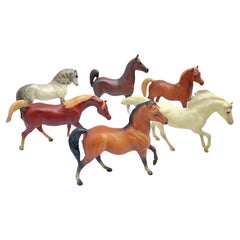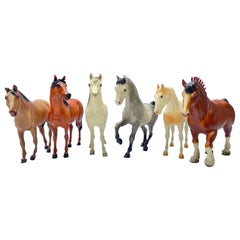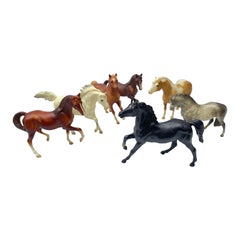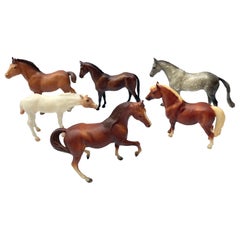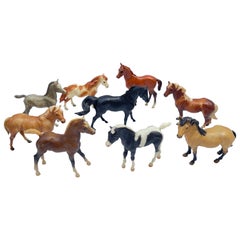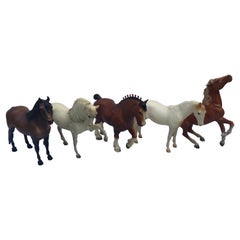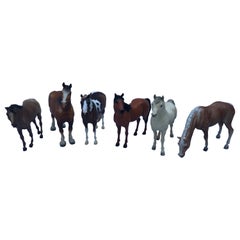Breyer Horses
Vintage 1970s Toys
Plastic
Vintage 1970s Toys
Plastic
Vintage 1970s American Toys
Plastic
Vintage 1970s Toys
Plastic
Vintage 1970s American Toys
Plastic
Vintage 1970s Toys
Plastic
Recent Sales
Vintage 1970s Toys and Dolls
Plastic
Vintage 1970s Toys
Plastic
Vintage 1970s Toys
Plastic
Vintage 1960s Toys and Dolls
Plastic
Materials: Plastic Furniture
Arguably the world’s most ubiquitous man-made material, plastic has impacted nearly every industry. In contemporary spaces, new and vintage plastic furniture is quite popular and its use pairs well with a range of design styles.
From the Italian lighting artisans at Fontana Arte to venturesome Scandinavian modernists such as Verner Panton, who created groundbreaking interiors as much as he did seating — see his revolutionary Panton chair — to contemporary multidisciplinary artists like Faye Toogood, furniture designers have been pushing the boundaries of plastic forever.
When The Graduate's Mr. McGuire proclaimed, “There’s a great future in plastics,” it was more than a laugh line. The iconic quote is an allusion both to society’s reliance on and its love affair with plastic. Before the material became an integral part of our lives — used in everything from clothing to storage to beauty and beyond — people relied on earthly elements for manufacturing, a process as time-consuming as it was costly.
Soon after American inventor John Wesley Hyatt created celluloid, which could mimic luxury products like tortoiseshell and ivory, production hit fever pitch, and the floodgates opened for others to explore plastic’s full potential. The material altered the history of design — mid-century modern legends Charles and Ray Eames, Joe Colombo and Eero Saarinen regularly experimented with plastics in the development of tables and chairs, and today plastic furnishings and decorative objects are seen as often indoors as they are outside.
Find vintage plastic lounge chairs, outdoor furniture, lighting and more on 1stDibs.
Finding the Right Toys for You
Children as well as nostalgic grown-ups are still finding pleasure in toys and objects designed specifically for playtime that are, in comparison to today’s digital device-oriented distractions, far more modest in nature. Indeed, antique, new and vintage toys of years past — handmade folk-art toys such as wooden train sets, dolls, rocking horses and more — can be enjoyed by the young and old alike. In contemporary interiors, gently aging toys are wonderfully uncomplicated decorative objects primed for display in a cabinet or other case piece.
With their romantic appeal and frequent incorporation of natural materials, some vintage toys and folk-art toys are treasured collectibles, showcasing the beauty of handmade craftsmanship. Alongside other works characterized as folk art — in this case, visual art, typically reflective of a community’s culture and usually handmade by craftspeople working within a popular tradition — handcrafted vintage toys are historical works of art worthy of any collector’s mantel. These are toys that tell a story of the time in which they were produced and the people who produced them.
Like any artifact, toys provide a window into the past. The ornamental dolls of the Victorian era, for example, produced in Germany and England, made of ceramics such as porcelain and dressed in textured fabrics, speak to the fashion of the era and will add a pop of color and a decorative flourish to the neutral corners of your home.
Mid-century modern toys are as sophisticated as the widely cherished furniture of the era. As much as they thought good design for the home should be available for all, iconic American design duo Charles and Ray Eames believed in making durable and interesting products for kids too. Today, their Eames Elephant is available from Vitra and Herman Miller, and it doesn’t even require a digital screen.
Explore a unique collection of antique and vintage toys as well as folk-art toys on 1stDibs.
Read More
A Giant Wedding Cake Has Us Looking at Portuguese Tiles in a New Light
At Waddesdon Manor, artist Joana Vasconcelos has installed a three-tiered patisserie inspired by the narrative tile work of her homeland. We take a look at the cake sculpture and how Portuguese tiles have been used in architecture from the 17th century to today.
Why Jules Chéret Was the King of the Modern Poster
The streets of fin-de-siècle Paris were set aglow with colorful poster ads, thanks to the printing techniques invented by Jules Chéret. Now, the Milwaukee Art Museum is celebrating this undersung talent in America's first solo show dedicated his exuberant works.
Why the American Flag Has Had So Many Different Star Patterns
Expert Jeff Bridgman explains the history and meaning behind the twinkling constellations that have graced Old Glory.
Peggy Guggenheim Loved Modernism, but She Also Collected Tribal Art
The iconoclastic style setter displayed African and Oceanic art, as well as works by indigenous peoples of the Americas, alongside pieces by such major modernists as Pablo Picasso and Jackson Pollock.
The 13-Star American Flag Had More Variations Than You’d Think
Perfect for July 4th weekend, a new show at Philadelphia's Museum of the American Revolution displays an array of antique red, white and blue flags.
Tramp Art, America’s Most Misunderstood Art Form, Is Trending in Interiors
Designers are beginning to see this enigmatic form of folk art in a whole new light.
